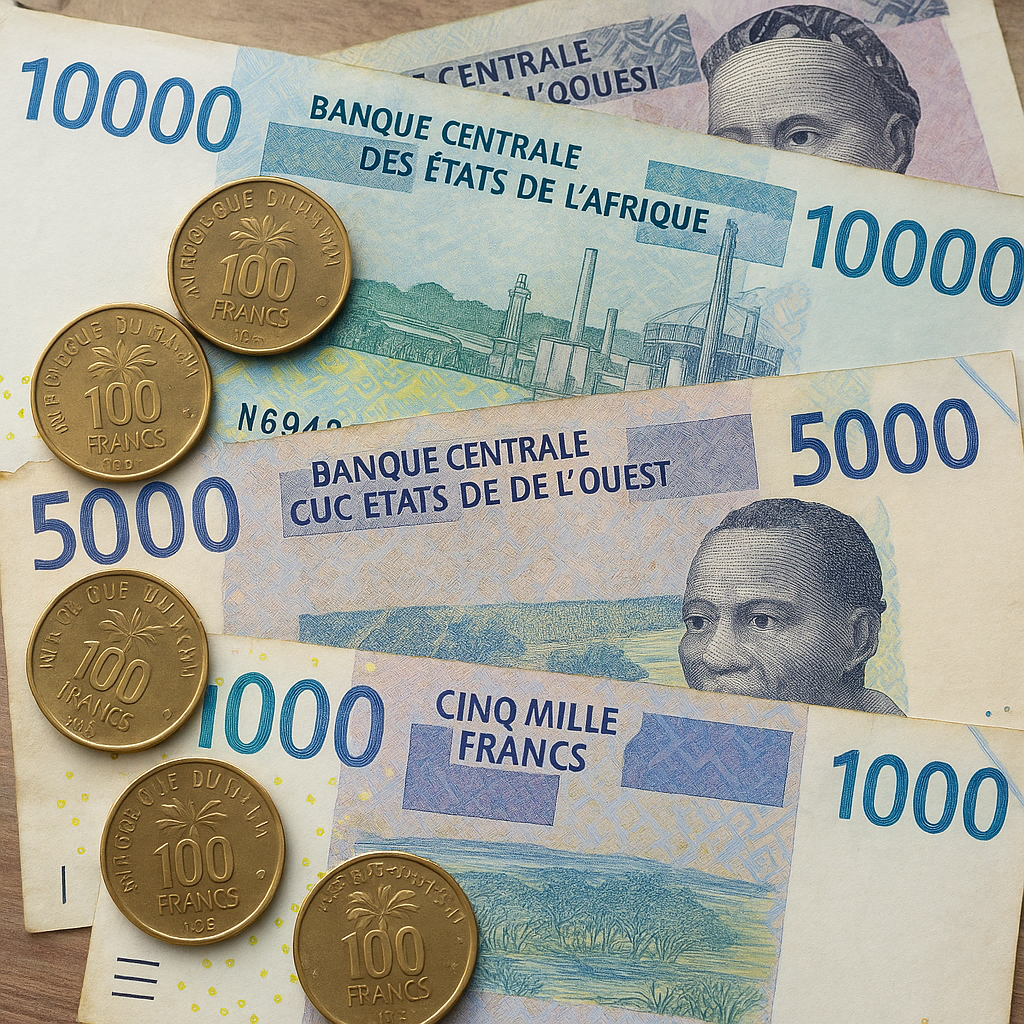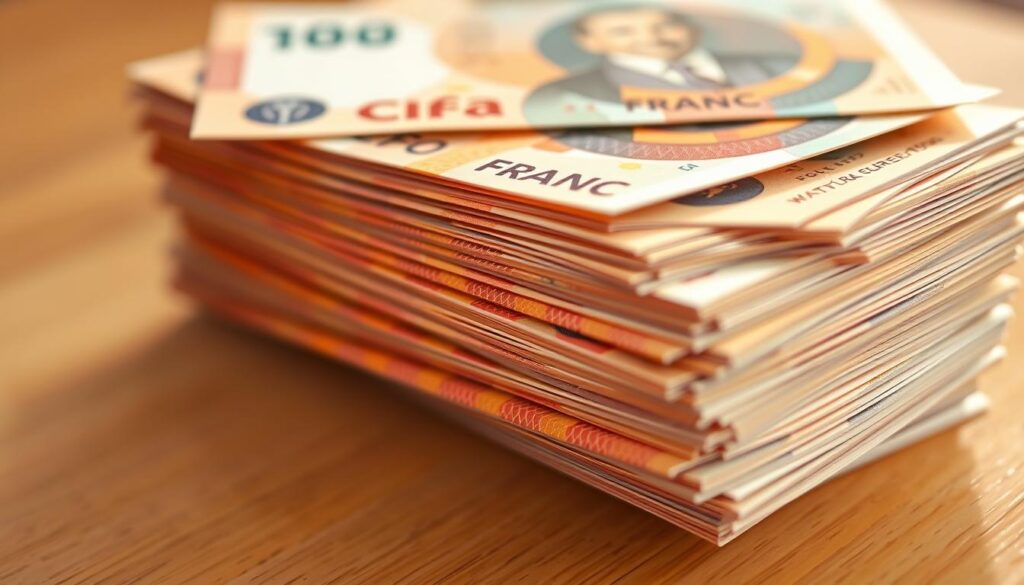
The West African CFA Franc (XOF) is Benin’s official currency. It’s used in eight West African countries. This makes trade and travel easier between them.
Having one currency simplifies things. The West African CFA Franc is tied to the Euro. This keeps the economy stable.
Key Takeaways
- The West African CFA Franc (XOF) is Benin’s official currency.
- Eight West African countries use the West African CFA Franc.
- The currency is pegged to the Euro, ensuring economic stability.
- The shared currency facilitates trade and travel across the region.
- The monetary policy has significant implications for Benin’s economy.
The Currency Landscape of Benin
Benin uses the West African CFA Franc, thanks to its membership in the West African Economic and Monetary Union (WAEMU). This membership affects Benin’s economic policies and currency management.
Overview of Benin’s Economic Profile
Benin’s economy mainly relies on agriculture, with cotton being a key export. The country aims to diversify its economy by boosting its industrial sector and improving trade with other countries.
The agricultural sector in Benin is big, employing many people. Crops like maize, cassava, and yams are also grown. Minerals like iron ore and gold play a role in the country’s economic growth.
Major Industries and Trade Partners
| Industry | Description | Trade Partners |
|---|---|---|
| Agriculture | Cotton, maize, cassava, yams | France, China, India |
| Manufacturing | Food processing, textiles | Nigeria, Togo, Ghana |
| Mining | Iron ore, gold | China, France, United Kingdom |
Benin’s Position in the West African Economic Landscape
Benin’s membership in WAEMU shows its commitment to regional economic integration. The West African CFA Franc makes trade easier among member states, boosting cooperation and stability.
Being part of WAEMU, Benin enjoys a common monetary policy by the Central Bank of West African States (BCEAO). This helps keep the economy stable and encourages the free flow of goods and services among members.
The economy of Benin is influenced by both national policies and regional participation. Knowing about Benin’s currency and economy helps us understand its growth and global integration.
What Currency is Used in Benin: The West African CFA Franc
In Benin, the West African CFA Franc is the official money. It helps with buying and selling things in the country and with other WAEMU countries.
Official Currency Designation and Code
The West African CFA Franc has the code XOF. This code is known worldwide. It’s used in money exchanges and economic deals.
Having a standard code makes international trade easier. It gives a clear way to identify the currency.
The Meaning Behind “CFA”
“CFA” in CFA Franc means “Communauté Financière d’Afrique” (Financial Community of Africa). It’s about the economic group of West African states using this money.
Eight countries in West Africa, including Benin, use the CFA Franc. The Central Bank of West African States (BCEAO) manages it.
Currency Symbol and International Recognition
The symbol for the West African CFA Franc is “CFAF.” It’s recognized worldwide through its code (XOF). It’s used in financial markets and money exchanges.
The value of the West African CFA Franc is tied to the Euro. This makes it stable. It also helps with economic ties with Europe.
Historical Evolution of the CFA Franc in Benin
In 1945, the CFA Franc became the official currency for French colonies in West Africa, including Benin. This change marked a big shift in the region’s monetary history. It replaced the French West African franc.
Colonial Origins
The CFA Franc was created during the colonial era. Its name comes from “Communauté Financière d’Afrique” (Financial Community of Africa). The currency was tied to the French franc, offering stability for the colonies.
France introduced the CFA Franc to unite its West African colonies economically. This move helped in trade and cooperation among the colonies and with France.
Post-Independence Developments
When Benin became independent in 1960, the CFA Franc stayed as the official currency. The country kept its ties with the West African Monetary Union, keeping the currency pegged to the French franc.
After independence, Benin and other West African Monetary Union members strengthened their economic bonds. The CFA Franc was key, helping in trade and investment.
Major Currency Reforms and Devaluation Events
The CFA Franc’s devaluation in 1994 was a major event. It was devalued by 50% against the French franc. This change marked a big shift in the West African Monetary Union’s monetary policy.
This devaluation had big effects on Benin and other countries. It changed trade balances, inflation, and economic stability.
The CFA Franc keeps evolving, with talks about its future and possible reforms. It’s still important for Benin’s economy, affecting trade, investment, and growth.
Physical Characteristics of Benin’s Currency
The West African CFA Franc is used in Benin. It comes in banknotes and coins with unique designs.
CFA Franc Banknotes: Designs and Denominations
CFA Franc banknotes range from 500 to 10,000 CFA Francs. Each has a special design. They feature West African culture and historical figures.
Key Features of CFA Franc Banknotes:
- Denominations: 500, 1,000, 2,000, 5,000, and 10,000 CFA Francs
- Security features include watermarks, holograms, and intricate patterns
- Designs reflect West African heritage and significant regional landmarks

CFA Franc Coins: Features and Values
CFA Franc coins range from 1 Franc to 500 Francs. They have different designs. These designs show the unity of West Africa.
Key Features of CFA Franc Coins:
- Denominations: 1, 5, 10, 25, 50, 100, 200, and 500 CFA Francs
- Coins are made from different metals, including aluminum and nickel
- Designs often feature symbols of West African unity and regional identity
The CFA Franc is Benin’s official currency. It’s widely used in daily transactions. This shows Benin’s role in the West African Economic and Monetary Union (WAEMU).
The West African Economic and Monetary Union (WAEMU)
Benin is part of WAEMU, which means it works with other countries in a unified way. The West African Economic and Monetary Union helps its members work together economically.
Benin’s Membership in WAEMU
Being in WAEMU shows Benin’s dedication to working together economically. It follows rules that help keep the economy stable and grow in the region.
Key aspects of Benin’s membership include:
- Participation in a common currency, the West African CFA Franc (XOF)
- Adherence to WAEMU’s economic convergence criteria
- Involvement in regional decision-making processes
Benefits of Monetary Union for Benin
The monetary union in WAEMU brings many benefits to Benin. Economic stability is improved with a common currency and shared policies. This stability draws in foreign investment and boosts trade in the area.
The benefits include:
- Increased economic stability through a common currency
- Enhanced regional trade and investment opportunities
- Improved economic governance through coordinated policies
Being in WAEMU helps Benin use the strength of its member states. This makes Benin’s economy stronger and more stable.
The BCEAO: Managing Benin’s Currency
The Central Bank of West African States, or BCEAO, manages Benin’s money system. It is the central bank for the West African Economic and Monetary Union (WAEMU) area. The BCEAO is key in keeping the West African CFA Franc stable.
Role and Functions of the Central Bank
The BCEAO issues the West African CFA Franc and sets monetary policy for WAEMU. Its main tasks are:
- Issuing and managing the CFA Franc currency
- Maintaining financial stability through wise monetary policies
- Supervising and regulating banks and financial institutions in WAEMU
- Helping with financial transactions between member states
The BCEAO’s decisions affect Benin’s economy. They influence inflation, interest rates, and growth.
Monetary Policy in the CFA Franc Zone
The BCEAO makes and carries out monetary policy for the CFA Franc zone. It aims to keep prices stable and support growth. The bank uses tools like:
- Setting interest rates to control inflation and affect borrowing costs
- Managing foreign exchange reserves to keep the CFA Franc stable
- Regulating the money supply to meet economic needs of member states
The BCEAO’s policy ensures the CFA Franc’s stability. It also promotes economic unity among WAEMU states.
| Monetary Policy Tool | Description | Impact on Economy |
|---|---|---|
| Interest Rate Setting | Adjusting interest rates to control borrowing costs | Influences inflation, consumption, and investment |
| Foreign Exchange Management | Managing foreign reserves to maintain currency stability | Affects exchange rates and trade balances |
| Money Supply Regulation | Regulating the amount of money in circulation | Influences economic activity and inflation |
The BCEAO’s good management of monetary policy is key. It keeps the CFA Franc stable. This supports the economic growth of Benin and other WAEMU states.
Exchange Rates and Currency Conversion for Benin’s CFA Franc
The CFA Franc’s exchange rate is tied to the Euro. This fixed rate has both good and bad sides. It affects how the CFA Franc is seen compared to other currencies.
Current Exchange Rates Against Major Currencies
Right now, 1 Euro is worth 655.957 CFA Francs. This fixed rate means the CFA Franc’s value changes with the Euro’s. For example, if the Euro gets stronger against the US Dollar, the CFA Franc gets stronger too.
Here are some current exchange rates for the CFA Franc against major currencies:
- 1 USD = approximately 585 CFA Francs
- 1 GBP = approximately 755 CFA Francs
- 1 EUR = 655.957 CFA Francs (fixed rate)
Historical Exchange Rate Trends
Since 1999, the CFA Franc’s value has moved with the Euro’s. It has seen times of stability and times of change, just like the Euro.
Some big events have changed the CFA Franc’s value:
- The Euro’s start in 1999 and the CFA Franc’s peg to it.
- The 2008 global financial crisis, which hit currency values hard.
- Recent changes in the Eurozone’s economy, affecting the Euro’s value.
Factors Affecting the CFA Franc’s Value
Many things affect the CFA Franc’s value, mainly its tie to the Euro. Other factors include:
- Economic conditions in West African Economic and Monetary Union (WAEMU) countries.
- Decisions by the Banque Centrale des États de l’Afrique de l’Ouest (BCEAO).
- Global prices of commodities, especially for Benin’s exports.
Knowing these factors is key for businesses and travelers using the CFA Franc in Benin.
The CFA Franc’s Relationship with the Euro
The CFA Franc’s tie to the Euro shapes Benin’s financial scene. The West African CFA Franc is pegged to the Euro at a fixed rate of 655.957 CFA Francs per Euro. This system started in 1999.

The Fixed Peg System Explained
The fixed peg system links the CFA Franc’s value directly to the Euro’s. The Central Bank of West African States (BCEAO) manages this system. It keeps the exchange rate steady.
This stability is key for international trade and finance. The Euro is a major global currency. The fixed peg system makes transactions with Eurozone countries easier.
It also attracts foreign investment. Investors trust the currency’s value more with a stable exchange rate.
Benefits and Challenges of the Euro Peg
The Euro peg brings monetary stability and reduced transaction costs with Eurozone countries. It also helps control inflation by linking the CFA Franc to the stable Euro.
But, there are challenges too. The peg limits WAEMU member states’ ability to set their own monetary policies. Benin can’t devalue its currency to boost exports or adjust to economic shocks on its own.
Another issue is relying on the European Central Bank’s (ECB) monetary policy. The ECB’s decisions on interest rates and quantitative easing affect the CFA Franc. These decisions might not always benefit Benin’s economy.
In summary, the CFA Franc’s peg to the Euro has both advantages and drawbacks. It offers stability and simplifies transactions with Eurozone countries. Yet, it restricts Benin’s monetary policy flexibility. Understanding this complex relationship is key to grasping Benin’s economic dynamics.
Using Currency in Benin: Practical Information for Travelers
Traveling to Benin means knowing about the local money, exchange options, and how to pay. The West African CFA Franc (XOF) is Benin’s official currency.
Currency Exchange Options in Benin
There are several ways to exchange money for the West African CFA Franc in Benin. Banks offer good rates. ATMs in big cities let you withdraw cash with your cards.
Currency exchange offices are also available, especially in tourist spots and near borders. It’s smart to compare rates and fees to find the best deal.
Tips for Exchanging Currency:
- Choose reputable banks and currency exchange offices to avoid scams.
- Know the current exchange rate to get a fair deal.
- Have local currency ready for immediate needs when you arrive.
Credit Card and Digital Payment Acceptance
Credit cards from big brands like Visa and Mastercard are accepted in many places in cities. But, cash is still the main way to pay, especially in rural areas.
Digital payments, like Orange Money and MTN Mobile Money, are becoming more common. They let you pay and send money with your phone.
It’s wise to carry both cash and credit cards. Also, learn about local digital payment options.
Tips for Managing Money in Benin
Here are some tips for managing your money in Benin:
- Keep your cash and cards safe, using hotel safes or secure bags.
- Tell your bank about your travel plans to avoid card issues.
- Have local currency for small buys and rural trips.
- Be careful with ATMs, avoid lonely spots, and cover your PIN.
Knowing about Benin’s currency and money management tips can make your trip better and less stressful.
Economic Implications of the CFA Franc for Benin
The CFA Franc is key for Benin’s economy. Being part of the West African Economic and Monetary Union (WAEMU), Benin’s economy is linked to the CFA Franc’s performance.
Advantages of the CFA Franc System
The CFA Franc brings stability to Benin, thanks to its tie to the Euro. This stability is crucial for attracting foreign investment. It lowers the risk of currency changes.
Also, the CFA Franc makes trade easier among WAEMU states. It creates a common economic zone. This makes transactions simpler and boosts economic integration.
| Advantages | Description | Impact on Benin |
|---|---|---|
| Economic Stability | Pegged to the Euro, reducing currency fluctuation risks | Attracts foreign investment |
| Simplified Trade | Common currency among WAEMU states | Promotes economic integration and trade |
Criticisms and Challenges of the Currency Arrangement
Despite its benefits, the CFA Franc system has its downsides. A big issue is the loss of monetary policy independence for Benin. This is because key decisions are made by the Central Bank of West African States (BCEAO).
Also, the fixed peg to the Euro can make Benin’s exports less competitive globally. This could hinder economic growth.
Impact on Trade and Foreign Investment
The CFA Franc’s effect on trade and foreign investment in Benin is complex. It attracts investors with its stability and regional integration efforts. Yet, its peg to the Euro might make it overvalued. This could scare off foreign buyers.
In summary, the CFA Franc has both good and bad sides for Benin. It offers stability and helps with regional trade. But, it also limits Benin’s control over its money and makes exports less competitive.
Conclusion
The West African CFA Franc is Benin’s official currency. It plays a big role in the country’s economy. Being part of the West African Economic and Monetary Union (WAEMU), Benin’s currency is tied to the Euro. This makes trade easier within the region.
Using the West African CFA Franc has its ups and downs. It brings stability, making transactions simpler and attracting investors. But, it also limits Benin’s control over its money, as the Central Bank of West African States (BCEAO) manages it.
Knowing about Benin’s currency is key for businesses, travelers, and investors. As Benin grows, its currency will keep being a key part of its economy.
FAQ
What is the official currency used in Benin?
The official currency in Benin is the West African CFA Franc (XOF).
What does “CFA” stand for in the context of the West African CFA Franc?
“CFA” means Communauté Financière d’Afrique, or Financial Community of Africa.
Is the West African CFA Franc used in other countries besides Benin?
Yes, it’s used in Burkina Faso, Côte d’Ivoire, Guinea-Bissau, Mali, Niger, Senegal, and Togo too.
What is the currency code for the West African CFA Franc?
The code for the West African CFA Franc is XOF.
How is the West African CFA Franc related to the Euro?
The CFA Franc is tied to the Euro at a fixed rate. This gives stability but limits the countries’ monetary policy freedom.
Can I use credit cards or digital payments in Benin?
Major cities in Benin accept credit cards and digital payments. But, cash is still the main way to pay, especially outside cities.
How can I exchange my currency for West African CFA Francs in Benin?
You can exchange your money for CFA Francs at banks, currency exchange offices, or some hotels in Benin.
What are the benefits of Benin being part of the West African Economic and Monetary Union (WAEMU)?
Being in WAEMU gives Benin a stable currency. It also makes trade easier among member states and promotes economic unity.
What is the role of the BCEAO in managing Benin’s currency?
The BCEAO issues the West African CFA Franc and manages monetary policy in the WAEMU region.
Are there any criticisms or challenges associated with the use of the CFA Franc in Benin?
Yes, there are. Criticisms include losing control over monetary policy because of the Euro peg. There are also worries about its impact on trade and foreign investment.
What are the advantages of using the West African CFA Franc for Benin’s economy?
The CFA Franc brings stability to Benin’s economy. It also lowers transaction costs for trade with other WAEMU countries. Plus, it attracts foreign investment because of the Euro peg.
Can the value of the West African CFA Franc fluctuate?
Although the CFA Franc is pegged to the Euro, its value can change against other currencies. This is based on the Euro’s value against those currencies.

Adam G
This post was created by Adam G, a seasoned financial writer with a passion for explaining currency exchange and market movements
